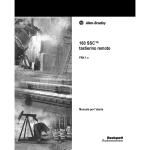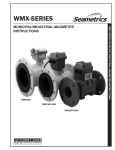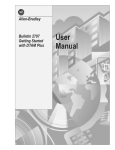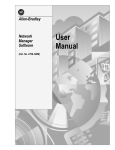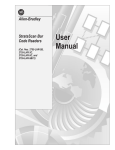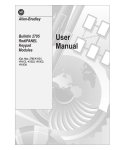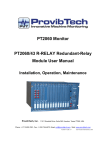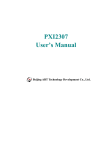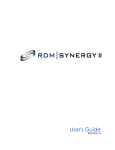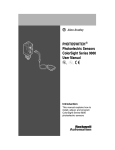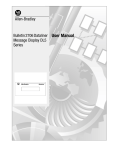Download 2706-806, DL5 Programming Software User Manual
Transcript
ALLEN-BRADLEY Allen-Bradley Dataliner DL5 Series Off-line Programming Software (Cat. No. 2706-NP5) User Manual Important User Information Solid state equipment has operational characteristics differing from those of electromechanical equipment. “Safety Guidelines for the Application, Installation and Maintenance of Solid State Controls” (Publication SGI-1.1) describes some important differences between solid state equipment and hard–wired electromechanical devices. Because of this difference, and also because of the wide variety of uses for solid state equipment, all persons responsible for applying this equipment must satisfy themselves that each intended application of this equipment is acceptable. In no event will the Allen-Bradley Company be responsible or liable for indirect or consequential damages resulting from the use or application of this equipment. The examples and diagrams in this manual are included solely for illustrative purposes. Because of the many variables and requirements associated with any particular installation, the Allen-Bradley Company cannot assume responsibility or liability for actual use based on the examples and diagrams. No patent liability is assumed by Allen-Bradley Company with respect to use of information, circuits, equipment, or software described in this manual. Reproduction of the contents of this manual, in whole or in part, without written permission of the Allen-Bradley Company is prohibited. Throughout this manual we use notes to make you aware of safety considerations. ! ATTENTION: Identifies information about practices or circumstances that can lead to personal injury or death, property damage, or economic loss. Attentions help you: • • • identify a hazard avoid the hazard recognize the consequences Important: Identifies information that is especially important for successful application and understanding of the product. Dataliner is a registered trademark of Allen-Bradley Company, Inc. Table of Contents DL5 Programming Software A–BUser Manual Using This Manual Chapter 1 Overview of this Manual . . . . . . . . . . . . . . . . . . . . . . . . . . . . . . . . . . . . Contents . . . . . . . . . . . . . . . . . . . . . . . . . . . . . . . . . . . . . . . . . . . . . . . . . Intended Audience . . . . . . . . . . . . . . . . . . . . . . . . . . . . . . . . . . . . . . . . . Conventions . . . . . . . . . . . . . . . . . . . . . . . . . . . . . . . . . . . . . . . . . . . . . . Installing the Software Chapter 2 Chapter Objectives . . . . . . . . . . . . . . . . . . . . . . . . . . . . . . . . . . . . . . . . . Before You Begin . . . . . . . . . . . . . . . . . . . . . . . . . . . . . . . . . . . . . . . . . Installing DL5.EXE . . . . . . . . . . . . . . . . . . . . . . . . . . . . . . . . . . . . . . . . Systems With 1 Hard and 1 Floppy or Micro Disk Drive . . . . . . . . . . . Systems With 1 Floppy or Micro Disk Drive . . . . . . . . . . . . . . . . . . . . Cabling Information 2–1 2–1 2–1 2–2 2–3 Chapter 3 Chapter Objectives . . . . . . . . . . . . . . . . . . . . . . . . . . . . . . . . . . . . . . . . . Cabling Information . . . . . . . . . . . . . . . . . . . . . . . . . . . . . . . . . . . . . . . Abbreviations . . . . . . . . . . . . . . . . . . . . . . . . . . . . . . . . . . . . . . . . . . . . . Catalog No. 2706-NC12 Serial Cable . . . . . . . . . . . . . . . . . . . . . . . . . . Catalog No. 2706-NC13 Serial Cable . . . . . . . . . . . . . . . . . . . . . . . . . . Catalog No. 2706-NC14 Serial Cable . . . . . . . . . . . . . . . . . . . . . . . . . . Catalog No. 2706-NC15 Serial Cable . . . . . . . . . . . . . . . . . . . . . . . . . . Running DL5 Off-line Programmer 1–1 1–1 1–1 1–2 3–1 3–1 3–2 3–2 3–3 3–3 3–4 Chapter 4 Chapter Objectives . . . . . . . . . . . . . . . . . . . . . . . . . . . . . . . . . . . . . . . . . Initial Start Up . . . . . . . . . . . . . . . . . . . . . . . . . . . . . . . . . . . . . . . . . . . . The Main Menu . . . . . . . . . . . . . . . . . . . . . . . . . . . . . . . . . . . . . . . . . . . Option 1 Baud Rate Selection . . . . . . . . . . . . . . . . . . . . . . . . . . . . . . . . Option 2 Terminal Mode . . . . . . . . . . . . . . . . . . . . . . . . . . . . . . . . . . . . Option 3 Edit or Create Messages . . . . . . . . . . . . . . . . . . . . . . . . . . . . . Naming a DL5 File . . . . . . . . . . . . . . . . . . . . . . . . . . . . . . . . . . . . . . Creating a New Message . . . . . . . . . . . . . . . . . . . . . . . . . . . . . . . . . Editing a DL5 File . . . . . . . . . . . . . . . . . . . . . . . . . . . . . . . . . . . . . . Editing Existing Messages . . . . . . . . . . . . . . . . . . . . . . . . . . . . . . . . F1 Help Screen . . . . . . . . . . . . . . . . . . . . . . . . . . . . . . . . . . . . . . . . . Deleting All Files for a DL5 Name . . . . . . . . . . . . . . . . . . . . . . . . . 4–1 4–1 4–2 4–3 4–4 4–5 4–6 4–8 4–12 4–14 4–14 4–15 i Table of Contents DL5 Programming Software User Manual Running DL5 Off-line Programmer Chapter 4 Option 4 Edit Print File Functions . . . . . . . . . . . . . . . . . . . . . . . . . . . . . Option 5 File Read / Write Functions . . . . . . . . . . . . . . . . . . . . . . . . . . Read from DL5 Memory to Disk . . . . . . . . . . . . . . . . . . . . . . . . . . . Write from a Disk to DL5 Memory . . . . . . . . . . . . . . . . . . . . . . . . . Option 6 Exit to DOS . . . . . . . . . . . . . . . . . . . . . . . . . . . . . . . . . . . . . . 4–16 4–17 4–18 4–19 4–21 Figures 3.1 3.2 3.3 3.4 Catalog No. 2706-NC12 Cable Catalog No. 2706-NC13 Cable Catalog No. 2706-NC14 Cable Catalog No. 2706-NC15 Cable ............................. ............................. ............................. ............................. 3–2 3–3 3–3 3–4 Chapter Descriptions . . . . . . . . . . . . . . . . . . . . . . . . . . . . . . . . . . . . . DL5 Programming Cables . . . . . . . . . . . . . . . . . . . . . . . . . . . . . . . . . Abbreviations . . . . . . . . . . . . . . . . . . . . . . . . . . . . . . . . . . . . . . . . . . . DL5 Message Attributes . . . . . . . . . . . . . . . . . . . . . . . . . . . . . . . . . . Display Special Functions . . . . . . . . . . . . . . . . . . . . . . . . . . . . . . . . . 1–1 3–1 3–2 4–10 4–13 Tables 1.A 3.A 3.B 4.A 4.B ii Chapter A–B 1 Using this Manual Overview of this Manual Read this chapter to familiarize yourself with the rest of the manual. You will learn about: • • • Contents Contents of this manual Intended audience Conventions used Table 1.A describes the chapters contained in this manual. Table 1.A Chapter Descriptions Chapter Intended Audience Title Purpose 1 Using this Manual Provides an overview of the manual. 2 Installing the Software Describes how to install DL5 off-line programming software onto your personal computer. 3 Cabling Information Describes the cable required to link the DL5 to your off-line programming computer. 4 Running DL5 Off-line Programming Software Describes how to use the off-line programming software. No special knowledge is required to use this manual. The user should have some familiarity with computer and communications terminology. 1–1 Chapter 1 Using this Manual Conventions In this manual, we use the following conventions. • • Screen displays are shown within a rectangular box. For example: Keys that you must press on your computer keyboard appear in capitalized letters within brackets. For example: Press [END] to return to main menu. • References to an [ENTER] key refer to the carriage return function of your keyboard and may appear on your keyboard as RETURN or 1–2 . Chapter A–B 2 Installing the Software Chapter Objectives This chapter describes how to load the DL5 Off-line Programmer into your personal computer. Before You Begin The Off-line Programmer is software for programming DL5 Message Displays. Using the Off-line Programmer is an efficient way to program several DL5s with the same message set. The DL5 messages are created using a personal computer and then downloaded to the display. You can also receive (upload) messages from a DL5 that has already been programmed. This software is menu driven with a new screen for each programming step. It can be used with the following systems: • • • Allen-Bradley 1784-T45, -T47, -T50, and -T60 Industrial Computers Allen-Bradley 6120 and 6121 Industrial Computers Most IBM PC AT and XT or compatible computers Off-line programming software is supplied on both a 5 1/4 inch floppy disk and a 3 1/2 inch micro disk. Be sure you have the disk that fits your system. Use this guide to get acquainted with the interactive programming software to create and maintain your own library of DL5 message display programs. Installing DL5.EXE This section shows you the procedure for installing the DL5 Off-line Programmer on your computer. Read the following important information before getting started on your system. Important: This software is copyrighted but not copy protected. It is recommended that you make a copy now and store the original disk in a safe place. You will need a blank disk. 2–1 Chapter 2 Installing the Software Installing DL5.EXE Installation procedures are given for the following types of computers: • • • Systems with 1 Hard and 1 Floppy (or micro) Disk Drive Systems with 2 Floppy (or micro) Disk Drives Systems with 1 Floppy (or micro) Disk Drive Use the installation procedure for your type of system. Systems with 1 Hard and 1 Floppy or Micro Disk Drive Important: The recommended procedure for off-line programming on a computer with one hard and one floppy or micro disk is to create a single sub-directory that will store the DL5.EXE file. Note: This installation procedure is for an IBM AT. Your computer will use the same or similar prompts and responses. 1. Make sure DOS is ready and that you are working on the hard disk. Normally the hard disk is the “C” drive, so the DOS prompt C: \ > is displayed. Note: Your DOS prompt could be different. See your computer’s DOS manual. 2. Insert the DL5 off-line programming disk into the floppy drive. Normally, this is the “A” drive. 3. Type: MD \ DL5 [ENTER] This step creates a sub-directory on the hard disk for the DL5 program and files. 4. At the DOS prompt (C: \ >) type: CD \ DL5 [ENTER] This step puts you into the DL5 sub-directory. While you are in the DL5 sub-directory, your computer will usually give you the sub-directory DOS prompt (C:\DL5>). 5. At the DOS prompt (C: \DL5>) type: COPY A:DL5.EXE [ENTER] The Off-line Programmer is now installed on your hard disk in the DL5 sub-directory. 6. Remove the DL5 off-line programming disk from the “A” drive and store it in a safe place. 7. At the sub-directory DOS prompt (C: \DL5>) type: DL5 [ENTER] and the off-line programming will begin. 2–2 Chapter 2 Installing the Software Systems with 1 Floppy or Micro Disk Drive Note: This installation procedure is for an IBM AT. Your computer will use the same or similar prompts and responses. Important: The recommended way of using Off-line Programmer on a computer with a single floppy or micro disk is to create a storage disk for your DL5 files. Storing files on the DL5 off-line programming disk restricts the number of files you can create. ! ATTENTION: Before you begin this procedure, ”write protect” your DOS disk by using a write protect tab. See your computer user manual. 1. Insert your computer’s “write protected” DOS disk into the disk drive and turn on the computer. 2. When the DOS prompt (A: \ >) is displayed, remove the DOS disk and insert the DL5 off-line programming disk. 3. Type: DL5 [ENTER] The Off-line Programmer will begin. 4. Before you begin programming, remove the DL5 off-line programming disk and insert a formatted storage disk. 2–3 Chapter A–B 3 Cabling Information Chapter Objectives This chapter describes how to connect your computer to a DL5. Cabling Information You will need a cable to connect your computer’s COM1 serial port to the RS-232 port on the DL5. The Off-line Programmer automatically uses the COM1 port for all communication functions including: setting the baud rate of the DL5, using your computer in Terminal Mode, and reading and writing files between your computer and the DL5. Consult your computer’s user’s manual if you are not sure which port is COM1. We recommend using an Allen-Bradley serial communications cable to connect your computer to a DL5. These cables provide the 9-pin “D” shell connections for your DL5’s RS-232 port and a “D” shell connector to plug into your computer. There are four cables available for serial communications connections to the DL5’s serial port. See Table 3.A for catalog numbers. Table 3.A DL5 Programming Cables Computer Allen-Bradley 1745-T45 Industrial Computer, VT-100, IBM XT, or compatibles. Allen-Bradley 6121 or T50 Industrial Computer, IBM AT, or compatibles Allen-Bradley 6120 Industrial PC/XT Computer Allen-Bradley 1770-T1 or 1770-T4 Industrial Terminal. Cable Port Connector Catalog Number Female DB-25 2706-NC12 Female DB-9 2706-NC13 Female DB-9 2706-NC14 Female DB-25 2706-NC15 You can construct your own cable according to the information provided in this section. The RS-232 serial port is accessible via a 9-pin subminiature male D-shell connector. The pin connections for cabling between the DL5 and various computer systems are included in this chapter. NOTE: A shielded cable is recommended to ensure accurate data transmission. 3–1 Chapter 3 Cabling Information Abbreviations Table 3.B describes the abbreviations used on the cable diagrams. Table 3.B Abbreviations Abbreviation Catalog No 2706-NC12 Serial Cable Signal CTS Clear to Send DCD Data Carrier Detect DSR Data Set Ready DTR Data Terminal Ready COM Signal Common RI Ring Indicator RTS Request To Send RXD Received Data TXD Transmitted Data Figure 3.1 illustrates the Catalog No. 2706-NC12 communications cable. Use this cable to connect the DL5 to: • • • Allen-Bradley 1745-T45 Terminal DEC VT100 IBM XT or compatible Figure 3.1 Catalog No. 2706-NC12 Cable DL5 Serial Port Female DB-9* Connector DCD TXD RXD DTR COM DSR RTS CTS RI Allen-Bradley 1745-T45 Terminal VT100 or IBM XT Serial Port Female DB-25* Connector 1 2 3 4 5 6 7 8 9 * = Gender specified is for the cable connectors. 3–2 8 3 2 20 7 6 4 5 22 1 DCD RXD TXD DTR COM DSR RTS CTS RI Chassis Ground Chapter 3 Cabling Information Catalog No 2706-NC13 Serial Cable Figure 3.2 illustrates the Catalog No. 2706-NC13 communications cable. Use this cable to connect the DL5 to: • • Allen-Bradley 6121 or 1784-T45, -T47, -T50, or -T60 Terminals IBM AT or compatible Figure 3.2 Catalog No. 2706-NC13 Cable DL5 Serial Port Female DB-9* Connector DCD TXD RXD DTR COM DSR RTS CTS Allen-Bradley 6121 or T50 Terminal or IBM AT & Compatible Serial Port Female DB-9* Connector 1 2 3 4 5 6 7 8 1 2 3 4 5 6 7 8 DCD RXD TXD DTR COM DSR RTS CTS * = Gender specified is for the cable connectors. Catalog No 2706-NC14 Serial Cable Figure 3.2 illustrates the Catalog No. 2706-NC14 communications cable. Use this cable to connect the DL5 to: • Allen-Bradley 6120 Industrial PC / XT Figure 3.3 Catalog No. 2706-NC14 Cable DL5 Serial Port Female DB-9* Connector DCD TXD RXD DTR COM DSR RTS CTS Allen-Bradley 6120 Serial Port Female DB-9* Connector 1 2 3 4 5 6 7 8 8 3 2 9 7 6 4 5 DCD RXD TXD DTR COM DSR RTS CTS 1 Chassis Ground * = Gender specified is for the cable connectors. 3–3 Chapter 3 Cabling Information Catalog No 2706-NC15 Serial Cable Figure 3.2 illustrates the Catalog No. 2706-NC15 communications cable. Use this cable to connect the DL5 to: • Allen-Bradley 1770-T1 or 1770-T4 Industrial Terminals Figure 3.3 Catalog No. 2706-NC15 Cable DL5 Serial Port Female DB-9* Connector DCD TXD RXD DTR COM DSR RTS CTS RI Allen-Bradley T3 Terminal Male DB-25* Connector 1 2 3 4 5 6 7 8 9 * = Gender specified is for the cable connectors. 3–4 8 3 2 20 7 6 4 5 22 DCD RXD TXD DTR COM DSR RTS CTS RI 1 Chassis Ground Chapter A–B 4 Running the DL5 Off-line Programmer Chapter Objectives This chapter describes how to use the DL5 off-line programming software. Initial Start Up When running the Off-line Programmer, the following screen displays: Use this screen to identify the type of monitor being used. After you type a [1] or [2], the Main Menu appears. 4–1 Chapter 4 Running DL5 Off-line Programmer The Main Menu Access Off-line Programmer functions from the Main Menu. Each function is described in the following sections. Option 1 - Baud Rate Selection Option 2 - Terminal Mode Option 3 - Edit or Create DL5 Messages Option 4 - Print File Functions Option 5 - File Read/Write Functions (Upload/Download) Option 6 - Exit to DOS 4–2 Chapter 4 Running DL5 Off-line Programmer Option 1 Baud Rate Selection Use the Baud Rate Selection option from the Main Menu to set the baud rate of the serial port (COM1) on your computer. The COM1 port will be connected to the RS-232 serial port on the back of the DL5. (See Chapter 3 for connection instructions.) To enable your computer to communicate with the DL5, both devices must be set to the same baud rate. Note: As shipped, the DL5 is initially configured for 9600 baud. COM1 must be set to 9600 baud for the initial communications with the DL5. After initial hook up, you can use the Off-line Programmer to change the baud rate to 300 or 1200. Note: It is recommended that the highest possible baud rate is selected. Read and write functions may timeout at 300 baud for certain computers. See the DL5 User Manual for details. At the prompt you can enter either [1], [2], or [3] or press [END] if you do not wish to change the baud rate. • • • • Enter [1] to select 300 baud Enter [2] to select 1200 baud Enter [3] to select 9600 baud Press [END] to set the baud rate and return to the Main Menu Note: The DL5 displays its baud rate upon power up. To determine if communication is established between COM1 and the DL5, select Terminal Mode from the main menu. 4–3 Chapter 4 Running DL5 Off-line Programmer Option 2 Terminal Mode Use the Terminal Mode Selection option from the Main Menu to make the computer function as a “dumb” ASCII terminal. This means that you will use your keyboard to respond to the prompts on the DL5. Refer to your DL5 User’s Manual (Publication 2706-805) for information about on-line programming from a “dumb” terminal. While in Terminal Mode, your computer screen will not display the characters you type. Instead, all characters typed on the keyboard will echo (display) on the DL5. Your computer screen will continue to display the Terminal Mode screen until you press [END] to return to the Main Menu. When Terminal Mode is selected, the screen displays the baud rate of the serial port (COM1). Use the Baud Rate Selection option to change the baud rate. Press [END] to return to the Main Menu. ! 4–4 ATTENTION: If you delete all messages in the DL5 using the Terminal Mode, you must wait until the DL5 is done with this step before proceeding. The DL5 will display ”Memory Lost” while it is still erasing its memory. After this step is complete, the DL5 will show the RUN? prompt. Then you can continue. Chapter 4 Running DL5 Off-line Programmer Option 3 Edit or Create DL5 Messages Select the Edit or Create DL5 Messages option from the Main Menu to create new messages or edit existing messages. In addition to programming messages, you can also specify the Special Functions for each DL5 and the Attributes for each message. This section shows how to: Name a DL5 File Create a New Message Edit a DL5 File Edit Existing Messages Edit Special Functions Use ”F1” Help Screen Delete All Files for a DL5 Name Whether you want to edit an existing message or create a new one, you must enter a DL5 name. The DL5 name refers to the display that uses a given set of messages. To select Edit or Create, use the instructions that follow. 4–5 Chapter 4 Running DL5 Off-line Programmer Option 3 Edit or Create DL5 Messages Naming a DL5 File 1. After selecting option 3 from the Main Menu, this screen appears: Before you name a DL5, you can view the lists of names that already exist on your storage disk. • • • • Type [CTRL] [G] to show all files for a particular DL5 name. Type [CTRL] [L] to show a list of existing DL5 names. Type [CTRL] [F] to show a list of all existing message files. Press [END] to return to Main Menu. Use the cursor control keys to scroll through the lists. 2. Enter a DL5 name. DL5 names can be up to 5 DOS allowable characters in length. All letters and numbers are valid. If you have chosen an existing DL5 name, go on to Creating a New Message or Editing the DL5 File. If you have entered a new DL5 name, continue on in this section. 4–6 Chapter 4 Running DL5 Off-line Programmer 3. After entering a new DL5 name the following screen appears: You will be required to enter information about the DL5 that you have just named. The program will store this information in a .CNF (configuration) file. The Off-line Programmer will create a .CNF file for each DL5 Message Display. The .CNF files are stored differently depending on the type of computer system as listed below. • • • For systems with 1 hard and 1 floppy or micro disk drives, the .CNF files are stored on the hard disk in the C:\DL5 directory. For systems with 2 floppy or micro disk drives, the .CNF files are stored on the floppy or micro disk in the ”A” drive (or other working drive). For systems with 1 floppy or micro disk drive, the .CNF files are stored on the floppy or micro disk that you have in your machine. Remember to replace your system disk with a storage disk before saving DL5 names and messages. ! ATTENTION: Deleting the configuration file from DOS will also delete the counter value that represents the total number of message blocks used in the DL5. See the edit screen on page 14 to see where the ”Total Used” counter data is shown. 4–7 Chapter 4 Running DL5 Off-line Programmer Option 3 Edit or Create DL5 Messages 4. Enter [1] at the first prompt if you have a one-line display or [2] if it is a two-line display. 5. Enter [1] at the second prompt if the DL5 has 0.5K memory, [2] if the memory size is 2K, or [8] if the memory size is 8K. Make sure the memory size you enter corresponds with the DL5 you are creating the messages for. The messages may not download if you specify the wrong memory size. You may select the default value of [2] by pressing the [RETURN] or [ENTER] key for both prompts. 6. Press [END] to save the configuration for this DL5 Message Display. Creating a New Message You can now create a message for the DL5 that you have named. You will also be able to define attributes for the message that will control how it is displayed on the DL5. 4–8 Chapter 4 Running DL5 Off-line Programmer 1. Enter a message number to create or edit. If the message number is above 999, you are not allowed to leave the field, but must enter a valid number. If you select Message #0 by pressing only the [RETURN] or [ENTER] key, you can edit Special Functions as described in Editing Special Functions. 2. To find the first unused message number, enter [?] in the message block. The first open message number will be displayed in the message number field. Press [ENTER] to edit that message. 3. After entering the Message Number, the list of message attributes appears on the lower half of the screen as shown below: Start entering your message text here. 4. Select the attributes for the message. The default values are highlighted on the screen. Refer to Table 4.A for attribute functions. Some attributes are mutually exclusive; you can select one but not both. The Off-line Programmer will not allow you to choose two mutually exclusive attributes. When an attribute does not apply to your situation, the cursor automatically advances to the next attribute that you will need to define. Define the attributes by pressing [Y] or [N] (or a number from 0 to 15 for Wait Time) and then pressing [RETURN] or the down [] arrow. Use the up [] arrow to go back up through the list of attributes. You can move through the list as many times as needed until you press [END]. 5. Press [END] to save the attributes for the message. 4–9 Chapter 4 Running DL5 Off-line Programmer Option 3 Edit or Create DL5 Messages Table 4.A DL5 Message Attributes Attribute Affect on Displayed Messages The Use Both Lines option will display the message on both lines of the display as a line mode message. A line mode message will display the first 16 characters of the message on the first line of the display and the next 16 Use Both Lines? ➀ characters on the second line of the display. For longer messages, the DL5 will display the first 2 lines for the specified Wait Time, and then repeat this process for the remaining blocks of the message. The Use Line 1 option will display the message only on the first line of the display. Any messages present on the second line will remain intact. The Use Line 2 option will display the message only on the second line of the Use Line 2 Only?➀ display. Any messages present on the first line of the display will remain intact. Use Least Used The Use Least option will display the message on the least recently used line. Line? ➀ Any messages present on the other line of the display will remain intact. The Scroll Mode option toggles between the scroll mode and line mode. In scroll mode the message scrolls across the display one character at a time from right to left. In line mode one message block (16 characters) is displayed at a time. If a message is longer than one block, the DL5 will display a message block for the specified Wait Time and then display the next block of the Scroll Mode? message. Use Line 1 Only?➀ Wait Time (0-15)? Auto Clear?➁ Auto Repeat?➁ Note: If you are using a two line DL5 and selected the Both Lines option, the line mode will be selected automatically. The Scroll Mode option becomes unavailable for selection after Both Lines has been chosen. Wait Time controls how long a message or a portion of a message is displayed. You must enter a value between 0 and 15. The unit of time being selected depends upon whether line or scroll mode was chosen. If Scroll Mode was chosen, the wait time is the amount of time that elapses, in tenths of a second, before the next character is scrolled on the display. If the Line Mode was chosen, the wait time is the amount of time, in seconds, that a message block is displayed. If you select the Auto Clear option, the DL5 will clear the display after the message has been displayed for the requested wait time. If you do not select the Auto Clear option, the last block of the message will remain on the display until it is replaced with another message. This attribute is used with scrolling messages or line mode messages longer than one screen in length. If you select the Auto Repeat option, the message continually re-triggers itself once the programmed Wait Time has expired. If you do not select the Auto Repeat option, the DL5 will display the message only once. The Flash Message option will cause the message to flash once per second while it is being displayed. ➀ These attributes are only applicable to 2 line displays. If you selected a one line display, the Off-line Programmer automatically prompts you for the attributes applicable for 1 line displays. ➁ These functions are applicable only with message triggers that are either binary or binary coded decimal (BCD) format. They are not applicable when the DL5 is in the round robin or priority mode. Flash Message? 4–10 Chapter 4 Running DL5 Off-line Programmer 6. After you have specified the attributes for the message, you can now enter the actual message. The DL5 stores messages in blocks of 16 characters. A message can be more than one block in length. You can view up to 16 message blocks on the Off-line Programmer’s Message Editing screen. Enter the text of your message. Press [F1] for help on moving the cursor and editing message blocks. The help screen is shown in the “F1” Help Screen section. 7. Press [END] to save the message. The program will create a .DL5 file for each message that you save. The individual message file names consist of the DL5 name, message number, and the extension .DL5. For example: The message file name shown in the screen on Page 9 was NEW100.DL5. ’NEW’ is the name of the DL5 display, ’100’ is the message number, and ’.DL5’ indicates that this is a message (not configuration) file. See Naming a DL5 File for information on .CNF files. The .DL5 files are stored differently depending on the type of computer system as listed below. • • • For systems with 1 hard and 1 floppy or micro disk drive, the .DL5 files are stored on the hard disk in the C:\DL5 directory. For systems with 2 floppy or micro disk drives, the .DL5 files are stored on the floppy or micro disk in the ”A” drive (or other working drive). For systems with 1 floppy or micro disk drive, the .DL5 files are stored on the floppy or micro disk that you have in your machine. Remember to replace your system disk with a storage disk before saving DL5 names and messages. 4–11 Chapter 4 Running DL5 Off-line Programmer Option 3 Edit or Create DL5 Messages Editing a DL5 File This section is divided into 4 parts: • • • • Editing Special Functions Editing Existing Messages “F1” Help Screen Deleting All Files for a DL5 Name After you enter an existing DL5 name, the Off-line Programmer will prompt you for a message number. There are 3 types of message numbers you can choose at this point: • • • A new message number. See Creating a New Message. Special Functions Message # 0. See Editing Special Functions. An existing message number. See Editing Existing Messages. Editing Special Functions When you enter message #0, the Special Function selections will be displayed as shown. The Special Function settings control how the DL5 will operate in the Run Mode. This step must be completed before the Off-line Programmer will allow you to download messages. 4–12 Chapter 4 Running DL5 Off-line Programmer There are four Special Functions. See Table 3.B for Functions and Options. Table 4.B Display Special Functions Special Function Option High True Parallel Port Logic Y N 3 1 9 DL5 RS-232 Port Baud Rate DL5 Run Mode NM PR BN BC RR Autorun Message Number A Valid Message Number Description Voltages on data lines are positive logic signals. Voltages on data lines are negative logic signals. DL5 Baud Rate set to 300 DL5 Baud Rate set to 1200 DL5 Baud Rate set to 9600 Parallel port uses NUMERIC run mode Parallel port uses PRIORITY run mode Parallel port uses BINARY run mode Parallel port uses BINARY CODED DECIMAL (BCD) run mode Parallel port uses ROUND ROBIN run mode This message will be displayed when the DL5 goes into Autorun Mode after power has been applied Note: Select 0 to disable the Autorun function. 1. Define the Special Functions settings by selecting the desired option code and then pressing [RETURN] or [ENTER]. You can move about within the menu by using the [RETURN] key or the up [] and down [] arrow keys. 2. Press [END] to save the Special Functions and return to the Edit screen. 4–13 Chapter 4 Running DL5 Off-line Programmer Option 3 Edit or Create DL5 Messages Editing Existing Messages When you edit an existing message, you may change either the text or the attributes of the message. The edit screen is shown below. 1. Press [CTRL] [A] to edit attributes. 2. Use the [RETURN] key or the up [] and down [] arrow keys to move the cursor through the list of attributes. 3. Press [END] to save the attributes. 4. Edit the message text. Press [F1] to see the Help Screen of edit commands or see the ”F1” Help Screen section on the next page. Note: If you decide that you prefer the old version of your message, press [ESC] to abort. Your message will remain unchanged. 5. Press [END] or [CTRL] [Q] to save your changes. The new version of the message is now stored in the .DL5 message file. 4–14 Chapter 4 Running DL5 Off-line Programmer ”F1” Help Screen The “F1” Help screen shows the list of edit commands that you can use to edit messages. The Help screen can only be accessed while you are editing a message. To see the Help screen press [F1]. The editing functions listed on the “F1” Help screen are shown in the table below: Press: To: [CTRL] A Edit message attributes. [CTRL] C Center text in block. [CTRL] D or [DEL] key [CTRL] E [CTRL] H, [BACKSPACE], or z [CTRL] I, [INS] key [CTRL] J, [TAB], [PG DN], or # [CTRL] K, [SHIFT] [TAB], [PG UP], or " [CTRL] L, or ! [CTRL] V, or [CTRL] X [HOME] key [ESC] key [END] key, or [CTRL] Q Delete Current Block. Erase complete message. Move cursor one character to the left. Insert Block after current position. Move cursor one block forward (right). Move cursor one block backwards (left). Move cursor one character to the right. Insert a variable in the message. Move cursor to first message block. Quit and do not save message or changes Quit and Save message. Press any key to exit the Help screen and continue editing the message. Deleting all Files for a DL5 Name Use the following procedure to delete all files for a specific DL5 name. These files can be deleted in DOS. Exit to DOS with Option 6 of the Main Menu. At the DOS prompt: A:\DL5> type the following command: DEL FILE NAME*.* [ENTER] Example: If you wish to delete the files for the DL5 named NEW, you would type the following at the DOS prompt: A:\DL5>: DEL NEW*.* [ENTER] All files for the DL5 named NEW would now be deleted. 4–15 Chapter 4 Running DL5 Off-line Programmer Option 4 Print File Functions Select option 4 - Print File Functions to print: • • • DL5 Messages Message Attributes Special Function Settings For this option, you must have a printer connected to the computer LPT1 parallel port. NOTE: Most printers are designed to hook up to the parallel port, but if your printer uses the serial input, you can redirect the printer output to a serial port such as COM2. You can do this before running the DL5 program at the DOS prompt by typing the following commands: MODE LPT1: =COM2 MODE COM2: 9600,N,8,1 These commands configure COM2 for a serial printer with 9600 baud, no parity, 8 data bits, and 1 stop bit. Note that these commands will require customization for your particular computer and/or printer. Consult your computer user’s manual for the exact commands required. 1. Enter the DL5 name to access the DL5 Messages that you would like to print. 2. Select the range of message numbers that you want to print. If you select or include Message #0, the Special Functions settings will be printed. 4–16 Chapter 4 Running DL5 Off-line Programmer 3. Answer [Y] or [N] if you want the message attributes printed. If you select [Y], they are printed for every message in the range you selected in Step 2. You may use the cursor control keys to change a message number before the last [ENTER] is pressed to begin printing. 4. Press [ENTER] to start printing after indicating whether or not to print the message attributes. 5. Press [ESC] to abort and return to the Main Menu. Option 5 File Read/Write Functions Select File Read/Write Functions from the Main Menu to transfer messages between your computer and the DL5 Message Display. You have the following choices: • • • Enter [1] to read an entire DL5 memory to a disk Enter [2] to write from disk to DL5 memory Press [END] to return to the Main Menu 4–17 Chapter 4 Running DL5 Off-line Programmer Option 5 File Read/Write Functions Read from DL5 Memory to Disk Reading from DL5 memory is similar to naming a DL5. You must supply configuration information so that the Off-line Programmer can store the messages correctly. After you have selected the read function, the following screen will appear: Before uploading messages from a DL5, you can view the lists of names that already exist on your storage disk. • • Press [CTRL] [L] to view existing DL5 names. Type [CTRL] [F] to view existing DL5 message files. Type in the DL5 name and press [RETURN] to begin uploading messages. Press [ESC] to abort the reading and return to the Main Menu if needed. After the first message is uploaded, the following screen will appear: 4–18 Chapter 4 Running DL5 Off-line Programmer 1. Enter [1] at the first prompt if you are reading from a one-line display or [2] if it is a two-line display. 2. Enter [1] at the second prompt if the DL5 has 0.5K memory, [2] if the memory size is 2K, or [8] if the memory size is 8K. You may select the default value of 2 by pressing the [RETURN] or [ENTER] key for both prompts. 3. Press [END] to save the configuration for this DL5 Message Display. Note: If you do not reply to the prompts on this screen, the upload will be aborted. Note: If you receive a communications error, check that your cable is securely connected to both the computer and DL5 and that the baud rate of COM1 matches the baud rate of the DL5. Also, using 300 baud rate may cause read functions to abort. It is recommended that a higher baud rate be used. Use Main Menu Option 1 - Baud Rate Selection to change the baud rate of the computer and Option 2 Terminal Mode to change the baud rate of the DL5. Write from a Disk to DL5 Memory When you enter 2 on the Read/Write Functions screen the following screen will appear. If you would like to see a list of DL5 names on your storage disk, press [CTRL] [L]. Otherwise, type in the DL5 name and press [ENTER]. Press [ESC] to return to the Main Menu if necessary. 4–19 Chapter 4 Running DL5 Off-line Programmer Option 5 File Read/Write Functions After typing the DL5 name and pressing [ENTER] the following screen appears: ! ATTENTION: DO NOT begin downloading messages while the DL5 is displaying ”Memory Lost”. This warning message will appear after the messages have been deleted (from the terminal mode) until the DL5 has completed the erasing operation. Note the warning message. Make sure that the selected messages are compatible with the DL5 connected to the computer: 1. Do not download messages that are created for a two-line display, to a one-line display and vice versa. 2. Do not download messages created for a DL5 which has more memory than the DL5 receiving the messages. For example; don’t download messages created for a DL5 with 2K memory (94 message blocks) to a DL5 with 0.5K of memory (21 message blocks). All of the messages may not fit. If you want to clear memory in the DL5 and download all of the messages for the DL5 name, simply press [ENTER] at this point. The software will automatically clear memory in the DL5 and download all messages. If Message #0 (DL5 input port and Special Function settings) does not exist, the software will not download the messages. Create Message #0 with Option 3, Edit or Create DL5 Messages. Then simply answer the questions. See the DL5 User Manual for more details on these settings. 4–20 Chapter 4 Running DL5 Off-line Programmer Download a range of messages only to a DL5 Memory. If (to save time) you only need to download a message or two because of some additions or modifications to that message, press [N] and [ENTER] to answer no to the download all messages question and this will bring up the following screen. Enter the first and last message in a range to download just those messages. This method does not “clear memory” before downloading, therefore: 1. Messages added to existing messages in the DL5 may exceed the DL5 memory capacity. Do not use this method of downloading messages if you do not know what messages are already in the DL5 memory. 2. Do not delete a message on the computer and then download a range including that message number to the DL5. The software erases each message in the DL5 individually prior to downloading that message. If there is no new message to download, the existing message in the DL5 will be left unchanged. Option 6 Exit to DOS Select Option 6 from the Main Menu to return to DOS. 4–21 Rockwell Automation helps its customers receive a superior return on their investment by bringing together leading brands in industrial automation, creating a broad spectrum of easy-to-integrate products. These are supported by local technical resources available worldwide, a global network of system solutions providers, and the advanced technology resources of Rockwell. Worldwide representation. Argentina • Australia • Austria • Bahrain • Belgium • Bolivia • Brazil • Bulgaria • Canada • Chile • China, People’s Republic of • Colombia • Costa Rica • Croatia • Cyprus Czech Republic • Denmark • Dominican Republic • Ecuador • Egypt • El Salvador • Finland • France • Germany • Ghana • Greece • Guatemala • Honduras • Hong Kong Hungary • Iceland • India • Indonesia • Iran • Ireland • Israel • Italy • Jamaica • Japan • Jordan • Korea • Kuwait • Lebanon • Macau • Malaysia • Malta • Mexico • Morocco The Netherlands • New Zealand • Nigeria • Norway • Oman • Pakistan • Panama • Peru • Philippines • Poland • Portugal • Puerto Rico • Qatar • Romania • Russia • Saudi Arabia • Singapore • Slovakia • Slovenia • South Africa, Republic of • Spain • Sweden • Switzerland • Taiwan • Thailand • Trinidad • Tunisia • Turkey • United Arab Emirates United Kingdom • United States • Uruguay • Venezuela Rockwell Automation Headquarters, 1201 South Second Street, Milwaukee, WI 53204-2496 USA, Tel: (1) 414 382-2000 Fax: (1) 414 382-4444 Rockwell Automation European Headquarters, Avenue Hermann Debroux, 46, 1160 Brussels, Belgium, Tel: (32) 2 663 06 00, Fax: (32) 2 663 06 40 Rockwell Automation Asia Pacific Headquarters, 27/F Citicorp Centre, 18 Whitfield Road, Causeway Bay, Hong Kong, Tel: (852) 2887 4788, Fax: (852) 2508 1846 World Wide Web: http://www.ab.com Publication 2706-806 – October 1992 Supersedes Publication 2706-806 – Dated January 1990 40061-089-02(A) Copyright 1992 Allen-Bradley Company, Inc. Printed in USA





































